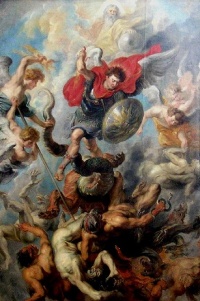War in Heaven

Origins
According to Mme. Blavatsky,
The “Fallen Angels” and the legend of the “War in Heaven” is thus purely pagan in its origin and comes from India viâ Persia and Chaldea. The only reference to it in the Christian canon is found in Revelations xii.[1]
In Theosophy
In Theosophical teachings the "war in heaven" is seen as a symbol that can be interpreted on several different levels (typically seven). The best known interpretation is related to another myth, that of The Fall of the Angels. As Mme. Blavatsky explained:
Mikael and his angels . . . refused to create as the seven passionless, mind-born, sons of Brahma did, because they aspire to incarnate as men in order to become higher than the gods. . . . The key which opens this mystery is the seventh key, and relates to the seventh trumpet of the seventh angel, after whose blast St. John sees the woman and “War in Heaven” (See Revelation, xi, 15, and xii, 7, and try to understand). This allegory, “War in Heaven,” has six other meanings; but this one is on the most material plane and explains the septenary principle.[2]
The symbols of the dragons and “War in Heaven” have, as already stated, more than one significance; religious, astronomical and geological events being included in the one common allegory. But it had also a Cosmological meaning.[3]
The “Fall of the Angels,” and the “War in Heaven” are repeated on every plane, the lower “mirror” disfiguring the image of the superior mirror, and each repeating it in its own way.[4]
Below are some instances of these interpretations:
To give it in its lowest symbolical aspect, this “war in heaven” is going on eternally. Differentiation is contrast, the equilibrium of contraries: and so long as this exists there will be “war” or fighting. There are, of course, different stages and aspects of this war: such for instance as the astronomical and physical. For everyone and everything that is born in a Manvantara, there is “war in heaven” and also on the earth. . . . There is a perpetual struggle of adjustment, for everything tends to harmonise and equilibrate; in fact it must do so before it can assume any shape. The elements of which we are formed, the particles of our bodies, are in a continual war, one crowding out the other and changing with every moment. . . . This refers to the formation of the Universe and the differentiation of the primordial primeval matter. But you must remember, that this is only the cosmogonical aspect,—one out of the seven meanings. The war in heaven had also immediate reference to the evolution of the intellectual principle in mankind. This is the metaphysical key.[5]
The allegorical war in Heaven; which became still more allegorical on Earth, for it was the war between spirit and matter. This war will last till the inner and divine man adjusts his outer terrestrial self to his own spiritual nature. Till then the dark and fierce passions of the former will be at eternal feud with his master, the Divine Man. But the animal will be tamed one day, because its nature will be changed, and harmony will reign once more between the two as before the “Fall,” when even mortal man was created by the Elements and was not born.[6]
Furthermore, the “War in Heaven” is shown, in one of its significations, to have meant and referred to those terrible struggles in store for the candidate for adeptship, between himself and his (by magic) personified human passions, when the inner enlightened man had to either slay them or fail. In the former case he became the “Dragon-Slayer,” as having happily overcome all the temptations; and a “Son of the Serpent” and a Serpent himself, having cast off his old skin and being born in a new body, becoming a Son of Wisdom and Immortality in Eternity.[7]
In Christianity
The Book of Revelation describes a war in heaven between angels led by the Archangel Michael against those led by "the dragon", identified with "the devil and Satan", who are defeated and thrown down to the earth. Revelation's war in heaven is related to the idea of fallen angels.
In Hinduism
Notes
- ↑ Helena Petrovna Blavatsky, The Secret Doctrine vol. I, (Wheaton, IL: Theosophical Publishing House, 1993), 198.
- ↑ Helena Petrovna Blavatsky, Collected Writings vol. VIII (Wheaton, IL: Theosophical Publishing House, 1990), 148.
- ↑ Helena Petrovna Blavatsky, The Secret Doctrine vol. II, (Wheaton, IL: Theosophical Publishing House, 1993), 384.
- ↑ Helena Petrovna Blavatsky, The Secret Doctrine vol. II, (Wheaton, IL: Theosophical Publishing House, 1993), 268.
- ↑ Helena Petrovna Blavatsky, Collected Writings vol. X (Wheaton, IL: Theosophical Publishing House, 1988), 371-372.
- ↑ Helena Petrovna Blavatsky, The Secret Doctrine vol. II, (Wheaton, IL: Theosophical Publishing House, 1993), 268.
- ↑ Helena Petrovna Blavatsky, The Secret Doctrine vol. II, (Wheaton, IL: Theosophical Publishing House, 1993), 380.
